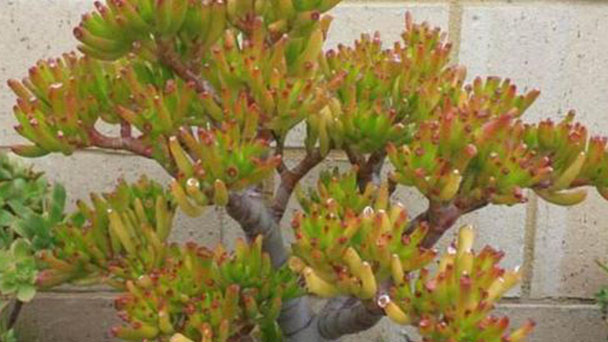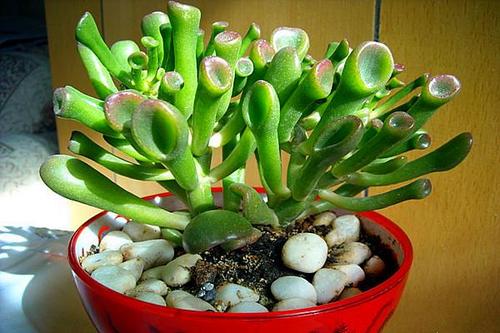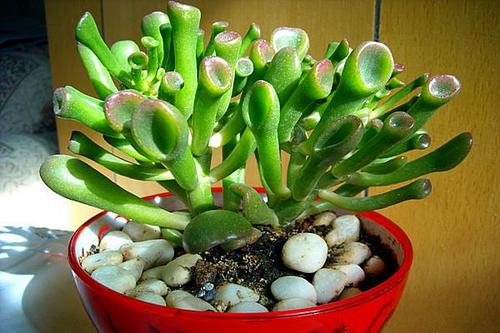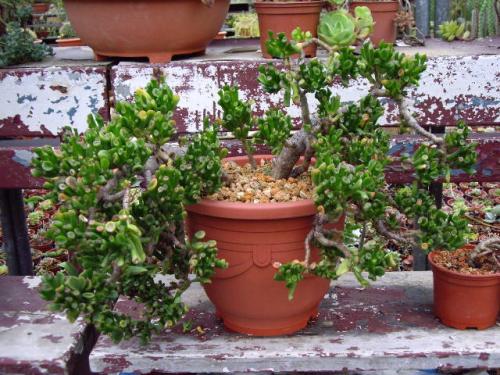Jade plant profile
Written by Maggie
Oct 18 2021

Jade plant, scientific name Crassula oblique, is a succulent plant of the genus Cyclosaurus. Jade plant is a very strong succulent plant. Origin for South Africa's Natal Province, the flower month tube shaped like a horseshoe section is also known as "horseshoe horn"; After the sun leaves red also known as "horseshoe red". Jade plant (Crassula oblique) is a much branched shrubby shape, the stem is obvious, round, the epidermis is yellowish brown or grayish brown. Leaves are alternate, growing in dense clusters at the tips of stems or branches, fleshy tubular, 4 cm to 5 cm long, 0.6 cm to 0.8 cm thick, oblique truncate at the top, usually elliptic in cross section, bright green, glossy, red at the edges of cross section in winter, very beautiful, a very strong variety.
Jade plant picture
Jade plant growing environment
Jade plant (Crassula oblique) likes warm, dry and sunny environments, drought and half shade, not cold. In addition to avoiding scorching sun insolation when high temperatures in midsummer, other seasons should give adequate illumination. Jade plant is native to South Africa for the horticultural variety, now the world can be cultivated in many places.
Jade plant ornamental value
The cross section of the Jade plant (Crassula oblique) looks like a horse's hoof, so it is called the horn of a horse's hoof. After the sun burns, the leaves will turn red, so it is also called the red of a horse's hoof. Its whole shape looks very beautiful, strange leaf type, bright color, very suitable for indoor potted culture, mainly to view leaves.
Jade plant propagation methods
Leaf cutting propagation
This method involves breaking off a healthy, mature tubular leaf at the lower part of the Jade plant for use. Insert the base of the removed tubular leaf diagonally into the soil, exposing most of it to the air, allowing for more photosynthesis, faster rooting, and higher survival rates. It is suggested that the leaves of other plants should be used to shade Jade plants and create an astigmatism environment to avoid excessive water loss from the leaves. The soil should be kept dry, otherwise it is difficult for roots to grow.
Sticks inserted propagation
This method of propagation of Jade plant (Crassula oblique) requires the removal of a strong and healthy branch for use after removing the underside leaves. Wait until the wound of the branch has shrunk, you can cut, in order to avoid rotten stem.If the base rotted, be sure to have the rotted part cut off, wait until dry later for cuttings. It is recommended to do it in spring or fall.
Layering and high pressure propagation
This method is the use of our Jade plant (Crassula oblique) stem air roots to contact the soil, and can be a safe and rapid propagation method. Especially if you breed in small quantities at home. The specific method is to soak the seedling block of Jade plant in water for a while, then take it out, cut it incomplete, and wrap the place where the air roots grow with a dark plastic bag, so as to avoid sunlight exposure and absorb heat and keep heat. It is necessary to use a syringe to supplement water. Later, when you add water, you can add a little bit of diluted fertilizer. After two or three months, if the roots are exposed, you can cut them open.

Jade plant is one of the plants that can grow in water
Jade plant growing methods
Jade plant (Crassula oblique) needs to receive sufficient sunshine to make the leaf color gorgeous and the plant type more compact and beautiful. Too little sunlight makes the leaves of Jade plant pale green, loosely arranged, elongated, and very tender. Jade plant is a medium and large plant. With the growth state, it can be changed once a few years. The diameter of the pot can be 2~3 inches larger than the diameter of the plant, which can promote the growth of the Jade plant. The medium must be dry before watering, and can apply slow effect fertilizer.
Jade plant (Crassula oblique) likes loose and breathable light acid soil, such as leaf rot soil, peat soil, can also make their own pH value is slightly acidic culture soil, avoided directly with heavy soil cultivation. Although its leaves have the function of discharging alkali, but in alkaline soil for a long time, plant growth will stagnate, leaves lose green and dull, easy to drop leaves and die. Watering at ordinary times must also ensure that the water is weak acid. Apply the whole element organic fertilizer once a month, few diseases and insect pests occur.
Jade Plant (Crassula oblique) also likes warm, wet and sunny environments. Jade plants are intolerant to shade, although can also grow in half shade, but the leaves will become slender, loose, plant shape is not plump, tall and straight, ornamental effect is not good.
The main value of jade plant
Jade plant (Crassula oblique) is a variety of horticulture with peculiar leaf shape and pleasant color. It is a kind of succulent plant mainly for leaf viewing.
Green leaves, evergreen, for office, bedroom, balcony furnishings, there are also a small amount of used to make succulent bonsai. Jade plant (Crassula oblique) is a very popular succulent boutique, and is the ideal indoor small leaf plant.

Latest Updated
- Benefits of Bugleweed - 7 Science-backed Health Benefits
- Bugleweed Dangers & Side Effects - Is It Poisonous?
- How to Plant Evergreen Trees - What You Should Know
- When to Plant Evergreens - Grow Guide for Evergreen Trees
- 12 Wonderful Evergreen Shrubs for Your Garden
- 12 Popular Evergreen Plants with Pictures for Beginners
- When And How To Prune A Lilac Bush Like a Pro
- How to Grow & Care for Lilac Vine (Hardenbergia Violacea)
- Japanese Lilac Tree (Syringa Reticulata) Care & Propagation Guide
- Shumard Oak Pros and Cons - What to Know
Popular Articles
- Winter maintenance of Antirrhinum Majus
- How to Grow Terminalia Mantaly Tree
- How to Grow and Care for Crossostephium Chinense
- How to grow Antirrhinum Majus in spring
- Peristeria Elata (Dove Orchid) Profile: Info & Care Guide
- Underwatered Snake Plant (Sansevieria Trifasciata) - Signs And How To Fix
- How to Care for Brazilian Jasmine Plant (Mandevilla Sanderi)
- How to Grow & Care for Graptopetalum Purple Delight in Summer
- Rosa Chinensis (China Rose): Plant Growing & Care Tips
- How to Care for Baby Sun Rose (Aptenia Cordifolia)
